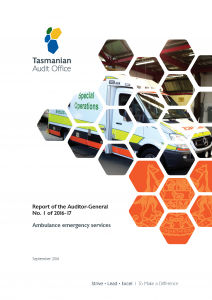About this report or communique
 Report of the Auditor-General No. 1 of 2016-17
Report of the Auditor-General No. 1 of 2016-17
Ambulance emergency services
The primary objective of an ambulance service, from a clinical perspective, is to provide optimal clinical outcomes for patients, including survival, cardiac arrest management, pain reduction and other appropriate care services within an appropriate response time. Aspects involved in doing so include following prescribed clinical practices and responding promptly, both of which are examined in this Report.
Emergency response times (response times) are one of the main performance measures for ambulance services throughout Australia and internationally. The standard used by a number of Australian jurisdictions is to respond to 90 per cent of Code 1 calls within 15 minutes.
Ambulance Tasmania’s (AT’s) responsiveness is dependent on a number of factors including the location of stations, availability of paramedics and volunteers, number of ambulance vehicles, quality of equipment and the health and ageing demographic profile of Tasmanians.
The challenge for AT is to manage service delivery targets in an environment of increasing demand for more ambulance services as our population continues to age.
Audit objective
The audit objective was to form an opinion on the effectiveness and efficiency of AT’s provision of emergency and urgent responses.
Audit scope
The audit was limited to AT, which is organisationally part of the Department of Health and Human Services.
Our approach involved assessing processes in providing emergency and urgent responses, assessing outcomes from clinical interventions and treatments and assessing the efficiency of AT.
The audit concentrated on the five-year period 1 July 2010 to 30 June 2015. More recent data was used where available.
Audit criteria
We developed a number of audit criteria, namely:
- Were AT’s clinical outcomes effective?
- Were AT’s response times for Code 12 emergency incidents effective compared with previous periods and compared with other jurisdictions?
- Were AT’s emergency services cost effective over time and compared with other jurisdictions?
- Were AT’s strategic management processes effective?

